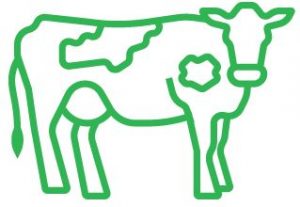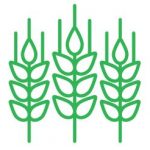MMPA is committed to cooperative social responsibility and sustainable business practices throughout our entire supply chain. At the farm level, MMPA members are also on a sustainability journey. We’re checking in with a handful of member farmers leading the charge with this sustainability spotlight series.

Pictured back to front, left to right: Mike Martin, Ben Martin, James Martin and Kyla Martin
It is all about the health of the soil for dairyman Mike Martin, who grazes 400 New Zealand Fresian Jersey crossbred cows on 170 acres of pasture in Wakarusa, Indiana. “To me sustainability and the health of the soil are very similar, from what I’ve learned is that having something green and growing on the soil is very healthy for its biology.”
Wakiana Dairy, a combination of Wakarusa and Indiana, began in 1984 when Mike and his wife Sue moved to the farm and started with 24 milking cows. Over time the couple expanded the operation and passed on their passion for farming to their son Ben, who works full-time on the farm.
Their mission is to, “Run a business that honors God by operating with integrity and honesty, producing healthy food for people, and using farming practices that are sustainable from generation to generation.”
For the Martins, the soil, cattle, and financial advantages are the primary components of their system, each complementing the others to facilitate the seamless functioning of the operation. “The soil thrives when it’s covered in grass and is grazed. Being out in the grass and grazing is healthier for the cattle. The grass is our cheapest and highest quality forage, therefore helps cut our cost of production.”
Their system begins with the soil. “We follow the growth of the grass. The growth of the grass is measured using a rising plate meter every 7-10 days, and the information from the meter is plugged into a spread sheet, from the University of Missouri, to track the growth rate of the pastures.” Cows are rotated to a new pasture twice a day, and fed baleage and a grain mix at the bunk as needed.
If pastures need to be seeded, a no till drill is used to sow a pasture seed mix. Mike explains, “I opt for Italian ryegrass as its very fast establishing, perennial rye grass for its high energy content, and clover because it grows well in the summer. Thanks to our high stocking rate, we only purchase a small amount of nitrogen fertilizer for the pasture.”
The Martins are also focusing on soil health by recently integrating an irrigation system. “In 2012, after a drought, we put in center pivots. In the summer when the pastures are dry, we give it water, and grass loves water.” Ben explains, “If you over apply then the ground gets too soft then the cows tear it up. We’re motivated to keep plenty of water for the grass to grow but not so much that it makes a mess, and costs more to run.” Plans are in the works to install water sensors that will provide feedback on moisture levels in the soil, allowing for more precision when making irrigation decisions.
They’re not just efficiently utilizing water; they’re also ensuring it remains within the soil, rather than flowing through the tile system. “It has taken us five years to gain 1% of organic matter in the soil and we are up to 5% organic matter today. When you have high organic matter soils you’re holding a lot more water in your soil, and that’s also holding your nutrients instead of washing them out,” Mike said. The Martins estimate that they have essentially zero erosion due to their diligence towards soil health. “It is amazing what grass can do.”
Mike is pleased with not only the quality of his soil but also in the welfare of his cows. “I am impressed with how long cows on grass can remain productive. Currently, we have 90 out of 400 cows over eight years of age. The cows last a long time and their milk and meat have a better nutrient profile, and so it is healthier for people to consume when the cattle are grazing. There is a better ratio of omega 3 to omega 6 fatty acids.”
To maintain economic stability in a volatile market, the Martins focus on keeping costs low. “We cannot control the price of milk, but we can focus on keeping costs low enough. That’s why there are no big barns here. We utilize the acreage we have to feed and house our animals.”
Mike’s advice to other producers is to, “Learn to think differently and beyond yourself. Sustainability is not just doing the same thing again and again; we must consider what is best for the future of the land. That’s what motivates me. I’m not going to be here forever, but I can do my part for as long as I am here to help things be sustainable.”
No Till Drill: Farmers use a no-till drill to plant in fields that they don’t till. The special no-till drill creates a channel that is just spacious enough for seeds to be planted, minimizing soil disturbance. No-till practices can minimize wind and water erosion and protect soil from high temperatures and moisture loss. In addition, organic matter from previous crops enriches the untilled soil.
Rising Plate Meter: A rising plate meter is a measurement tool to estimate the approximate forage available in a pasture. It’s more accurate than just measuring pasture height, because it takes into account the density of the pasture.
Center pivot irrigation: A self-propelled irrigation system in which a single pipeline supported on towers rotates around a central point. These systems are typically about one quarter mile long and serve 128-to 132-acre circular fields.
SOURCE: U.S. Department of Agriculture

FARM
Wakiana Dairy
Wakarusa, Indiana

HERD
400 milking cows

LAND
227 acres of pasture and 145 acres of hay

VERIFICATIONS
MMPA sustainability survey, FARM* Animal Care and FARM* Environmental Stewardship evaluations.
This article was originally published in the May/June 2024 issue of the Milk Messenger. Subscribe »

